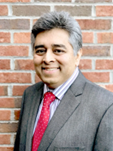| Prof. Farhan Gandhi Rosalind and John J. Redfern Jr Chair in Engineering |
 |
Biography: Farhan Gandhi obtained his PhD in Aerospace Engineering from U of Maryland’s Alfred Gessow Rotorcraft Center in 1995. After 17 years on the Penn State Aerospace Faculty, he moved to Rensselaer Polytechnic Institute in 2012 as the Redfern Chair in Aerospace Engineering. In Spring 2018, he assumed responsibilities as Founding Director of RPI’s Center for Mobility with Vertical Lift (MOVE). Gandhi is an AIAA Fellow, a Technical Fellow of the Vertical Flight Society, and a Fellow of the Royal Aeronautical Society. He has chaired multiple major technical conferences and technical committees. A top experts in VTOL aircraft aeromechanics, advanced VTOL configurations (including multi-rotor eVTOL aircraft for Urban Air Mobility), reconfigurable vertical lift, and adaptive structures, he held a Joint Faculty Appointment with the US Army Research Lab, Vehicle Technology Directorate (2018-2021). Over a 28-year academic career, Gandhi has published over 115 journal papers, 240 conference papers, and advised 28 PhD students to graduation. He currently leads a vibrant research group comprising of 2 research scientists and 10 PhD students. Gandhi has been a plenary/keynote speaker at several major technical conferences and has delivered prestigious lectures such as the 2022 Royal Aeronautical Society’s Cierva Lecture in VTOL aircraft, and the 2019 AIAA Adaptive Structures Lecture.
Topic: Autonomous morphing in rotary-wing systems
Abstract: Since the optimal geometric configuration for an aircrcraft (and other vehicles) can differ depending on the operating condition, morphing provides the ability to operate close to optimality at multiple diverse operating conditions, and even expand the operating envelope considerably. The big fundamental challenge with morphing aerospace structures has been the design of structures that are simultaneously rigid enough to carry the external aerodynamics and inertial loads, and at the same time compliant enough so that the actuation requirements (actuation power, actuator size, etc.) are not prohibitive. Other challenges include material strain capability and requirement for flexible skins. The use of novel materials and innovative structual design has certainly advanced morphing technology over the last decade-and-a-half. This presentation delves into a specific morphing concept -- that of autonomous shape change -- and seeks to advance this concept by providing several examples and discussing future opportunities. Examples covered will include those where RPM change of rotor blades (e.g., helicopter and wind-turbine blades), and the resulting change in centrifugal force are exploited to morph rotor blade span, and chord and twist distribution. Examples will also be provided where temperature change can be used to produce wing camber morphing to expand the operating envelope of the vehicle. Other possibilties where change in pressure distribution can be used to induce or assist in shape morphing will also be discussed.